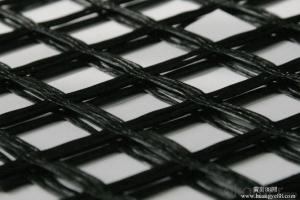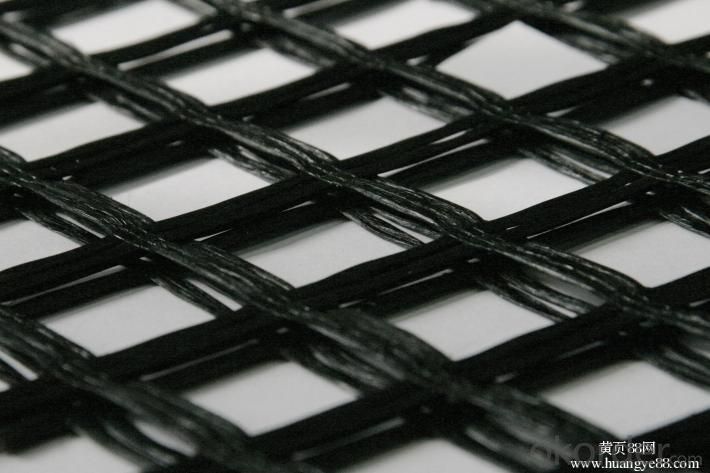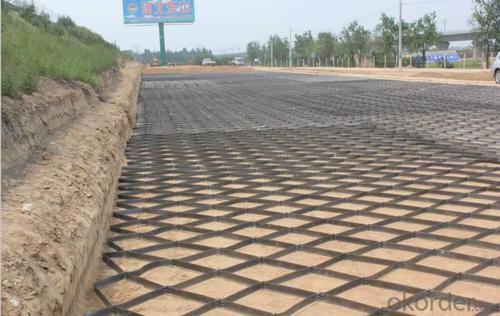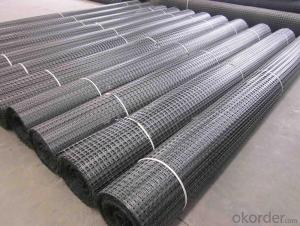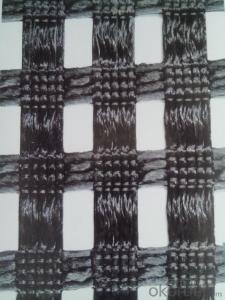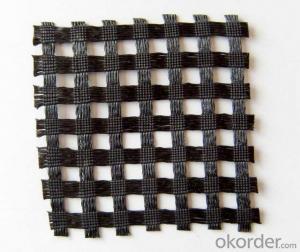High Tensile Strength Interlock Biaxial Geogrids
- Loading Port:
- Qingdao
- Payment Terms:
- TT OR LC
- Min Order Qty:
- 3000 m²
- Supply Capability:
- 1000000 m²/month
OKorder Service Pledge
OKorder Financial Service
You Might Also Like
Structure of Fiberglass Geogrid
Fiberglass geogrid is A kind of planar mesh material using alkali-free fiberglass yarn as base body and
then coated with high quality modified asphalt.. The products after surface covering own the favorable property of alkali resistance and aging resistance
Main Features of the Fiberglass Geogri
High quality asphalt coation
Light weight, high tensile, corrosion resistance
Road maintenance and reinforcement
Packaging & Delivery
| Packaging Details: | PP bags or PE film. Or Packed as customers' requests. |
| Delivery Detail: | 10-20days after the contract is effective |
Fiberglass Images


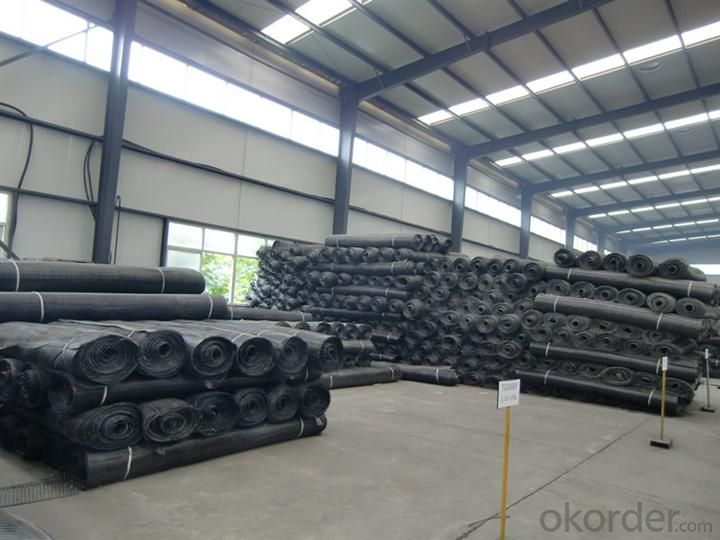
Fiberglass Geogrid Specification
Converting old cement concrete road into composite road.
Restraining reflection cracking caused by block shrinkage.
Preventing and controlling the cracking caused by new and old combination and uneven settlement.
Road extension.
Reinforcement of soft soil foundation and overall strength of roadbed
Property | Test Method | TGSG 15-15 | TGSG 20-20 | TGSG 30-30 | TGSG 40-40 | |
Ultimate tensile strength(1) (kN/m) | MD |
ASTM D 6637 | 15 | 20 | 30 | 40 |
CD | 15 | 20 | 30 | 40 | ||
Elongation at maximum load (%) | MD | 13 | ||||
CD | 13 | |||||
Tensile strength at 2 % elongation (kN/m) | MD | 5 | 7.5 | 10.5 | 14 | |
CD | 5 | 7.5 | 10.5 | 14 | ||
Tensile strength at 5 % elongation (kN/m) | MD | 7 | 14 | 21 | 28 | |
CD | 7 | 14 | 21 | 28 | ||
Minimum Carbon Black | % | ASTM D 4218 | 2 | |||
FAQ
We have organized several common questions for our clients,may help you sincerely:
Q: How about your company?
A:Our company are one of the largest geosynthetic products supplier in the world.We have the products experience more than 20 years.Already export to USA/Germeny/Australia/Zambia/Brazil etc.more than 20 countries.Almost 10years.Our products including Geocell/Fiberglass Geogrid/Geomembrane/Geotextile/Geonet etc.
Q.Does your products have good qualitity?
A:Yes,we have do many big projects such as the 2008 Beijing Olympic BIRD NEST. Divert water from the south to the north project. And our products have CE certificate also.
Q:How long can we receive the products after purchase?
A:In the purchase of product within three working days, We will arrange the factory delivery as soon as possible. The pecific time of receiving is related to the state and position of customers.Commonly 15-20 working days can be delivery.
- Q: Can geogrids be used in shoreline erosion control projects?
- Yes, geogrids can be used in shoreline erosion control projects. Geogrids are often used to stabilize and reinforce soil in coastal areas to prevent erosion and maintain the integrity of shorelines. They can be installed to reinforce slopes, prevent soil movement, and provide structural stability to prevent further erosion.
- Q: Do geogrids provide reinforcement to geosynthetic clay liners?
- Yes, geogrids can provide reinforcement to geosynthetic clay liners. Geogrids are typically used in combination with geosynthetic clay liners to improve their tensile strength and overall performance. The geogrids help distribute loads and restrain the movement of the clay liners, enhancing their stability and reinforcement capabilities.
- Q: What are the specifications of fiberglass geogrid for Asphalt Pavement
- The use of asphalt pavement can only use fiberglass grille, the other are used on the top of the embankment
- Q: Are geogrids suitable for use in soil reinforcement for coastal protection structures?
- Yes, geogrids are suitable for use in soil reinforcement for coastal protection structures. Geogrids are commonly used in such applications as they provide effective reinforcement by distributing the loads and stabilizing the soil. They help to prevent erosion and improve the stability and durability of coastal structures, making them a reliable solution for coastal protection.
- Q: How do geogrids improve the performance of geocomposites?
- Geogrids improve the performance of geocomposites by adding tensile strength and stabilization to the overall structure. They enhance the load-bearing capacity and reduce deformation, effectively reinforcing the geocomposite system.
- Q: Glass steel grille is how to produce
- Production process of FRP grid:Preparation of mold - Preparation of mixed resin - glass fiber yarn - (or at the same time) pouring resin and exhaust bubble - mold heating, product curing - mold - finishing - Inspection packaging.
- Q: What are the design considerations for geogrids in reinforced soil slopes?
- Some of the key design considerations for geogrids in reinforced soil slopes include the selection of appropriate geogrid material and strength, determining the required spacing and orientation of the geogrid layers, considering the slope geometry and stability requirements, evaluating the soil properties and potential for settlement and deformation, assessing the long-term durability and performance of the geogrids, and ensuring adequate constructability and installation techniques. Additionally, factors such as water drainage, environmental conditions, and cost-effectiveness should also be taken into account during the design process.
- Q: What is the overlap length of the two-way geogrid? What is the overlap length of geotextiles?
- Steel nail. Geotextile lap length is 50cm to 1m
- Q: Geogrid construction must be folded back 2m wrapped in compacted packing
- Geogrid in flat lower bearing layer according to design requirements of the laying of the width, lower filler unarmed bad geogrid debris, geogrid, the high strength in the direction perpendicular to the axial direction of embankment layout, geogrid transverse laying, laying taut, stretched, and avoid wrinkle twist or potholes, geogrid along the longitudinal splicing by overlapping method, lap width not less than 20cm.
- Q: What are the differences between uniaxial and biaxial geogrids?
- Uniaxial geogrids are designed to provide strength and stability in one direction, typically in a single plane. They have high tensile strength in one direction, making them suitable for applications such as soil reinforcement in retaining walls and embankments. On the other hand, biaxial geogrids are engineered to provide strength and stability in two perpendicular directions. They have high tensile strength in both the longitudinal and transverse directions, allowing them to distribute loads more uniformly. This makes biaxial geogrids versatile for various applications such as soil stabilization, slope reinforcement, and pavement reinforcement. In summary, the main difference between uniaxial and biaxial geogrids lies in their tensile strength orientation, with uniaxial geogrids providing strength in one direction and biaxial geogrids offering strength in two perpendicular directions.
Send your message to us
High Tensile Strength Interlock Biaxial Geogrids
- Loading Port:
- Qingdao
- Payment Terms:
- TT OR LC
- Min Order Qty:
- 3000 m²
- Supply Capability:
- 1000000 m²/month
OKorder Service Pledge
OKorder Financial Service
Similar products
Hot products
Hot Searches
Related keywords
